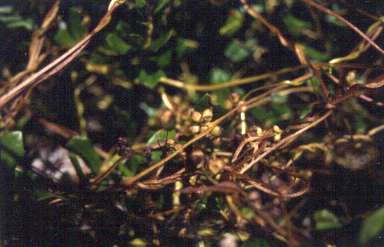Plants of South Florida · Plants by Conservation Area · Plants by County · Plants by Habitat Quick Search · Advanced Search |
||
|
|
||
 |
Cuscuta exaltata Engelm. Tall dodder |
|
|
South Florida Status: Critically imperiled. Four occurrences in five (or six) conservation areas (Jupiter Ridge Natural Area & Juno Dunes Natural Area; Jupiter Inlet Lot 13 and/or Jupiter Inlet Natural Area; Rocky Point Hammock; Yamato Scrub Natural Area). Taxonomy: Dicotyledon; Convolvulaceae. Habit: Annual parasitic vine. Distribution: Native to Florida and Texas. Wunderlin (1998) reports it as rare in Florida from the northern counties south to the central peninsula. South Florida Distribution: Martin and Palm Beach counties. South Florida Habitats: Scrub and scrubby flatwoods. Protection Status: Not listed by any agency. Aids to Identification: Austin (1980) has an illustration; the IRC Website has a color photo. References: Yuncker, 1932; Small, 1933a; Austin, 1980; Godfrey & Wooten, 1981; Wunderlin, 1998. Synonyms: None. Historical Context: Palm Beach County biologist Steve Farnsworth first reported an unknown Cuscuta species for several sites in northern Palm Beach County: Jupiter Inlet Tract (Farnsworth, 1993c), part of which is now Jupiter Inlet Natural Area and part of which is now Jupiter Inlet Lot 13; Jupiter Ridge Natural Area (Farnsworth, 1994b); and, Juno Dunes Natural Area (Farnsworth, 1995a). Daniel F. Austin observed these plants and reported that they were all C. exaltata (personal communication, 3 April 2001). In July 2001, Chris Lockhart observed plants at the Juno Dunes Natural Area (personal communication, 25 July 2001), a station that was vouchered by Lytton Musselman in 2001 (personal communication, 14 January 2002). Plants at Jupiter Ridge Natural Area are assumed to be present, as are plants at the Jupiter Inlet Tract, although both the Jupiter Inlet Natural Area and Jupiter Inlet Lot 13 need to be surveyed. In 1998, Bradley and Woodmansee discovered tall dodder at Yamato Scrub Natural Area in southern Palm Beach County (1006, FTG, USF). A single large patch of plants was observed growing parasitically on oaks (Quercus spp.) in a recently cleared firebreak. Austin observed this station in April 2001, and saw two-dozen or more seedlings (personal communication, 5 April 2001). Also in 1998, Bradley and Woodmansee discovered tall dodder in Martin County in scrubby flatwoods at Rocky Point Hammock, a Martin County park (1206, FTG). A single patch was observed growing parasitically on Quercus myrtifolia. Major Threats: Exotic pest plant invasions; fire suppression. Comments: Tall dodder is parasitic on a variety of hardwood hosts (Godfrey & Wooten 1981). It flowers in the summer through fall, so surveys should be conducted during this time period. It appears to be an extremely ephemeral species, sometimes disappearing for years at a time (D.F. Austin, personal communication, 3 April 2001). Recommendations: • Voucher plants at Jupiter Inlet Tract and Jupiter Ridge Natural Area. • Voucher all stations each year plants are present. • Survey Jupiter Inlet Natural Area and Jupiter Inlet Lot 13. • Map known stations whenever plants are present. • Monitor known stations on a quarterly basis. • Conduct conservation biology research. • Determine status in Florida and Texas. • Review for listing by FDACS and FNAI. |
||



